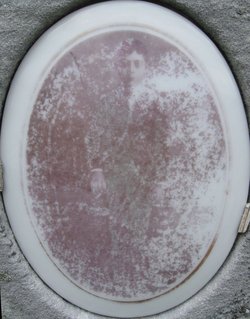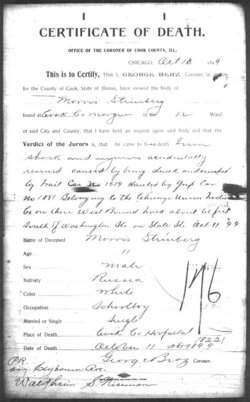As the day drew to a close on December 11, 2012, Evanston, Illinois became a different place, but few took notice. December 12th would be the first day since 1883 that there was not a house standing at 301 Asbury Avenue. It was torn down by order of the City of Evanston because it had become a hazard to the safety of its citizens.
 |
| 301 Asbury, 2007 |
When the house at 301 Asbury was built in 1883, buildings in Evanston were not even numbered - in fact 301 was not in the City of Evanston at all - it was built in the Village of South Evanston, and did not become part of Evanston itself until South Evanston was annexed in 1892.
When the house at 301 was built, the streets of this part of South Evanston had not even been laid out. Asbury Avenue was there, but it was an unpaved dirt road this far south. Major Edward Harris Mulford, the original owner of the 160 acre estate “Oakton” that reached from Howard to Oakton and Asbury to Custer (called Rinn Street back then) had only been dead for four years. Mulford’s granddaughter Anna Mulford Brown was just beginning to subdivide the estate and sell it off piece by piece.
When I was a boy, Major Mulford’s house on the northwest corner of Ridge and Harvard Terrace was still standing. The last piece of the original estate, it was sold and razed in 1963 so the first condominium in Evanston could be built.
In 1883 the Village of South Evanston was populated with immigrants from Germany and France and Luxembourg - people with names like Muno and Leider and Schaul.
301 Asbury, the two story frame house with the barn out in back, provided a home to many of these early settlers as well - distant relatives but part of my own family: The house was originally built by John N. Didier (Jean-Nicholas Didier), a gardener, and various members of the Didier and Faber family lived there until the mid 1950s.
Here is a photo of John N. Didier with his second wife Elizabeth (nee Reding) and his eleven children:
Over the years many of the Didiers lived at 301 Asbury. Here are the listings from the South Evanston, then the Evanston City Directory:
1883 - (Referred to as Asbury av. cor Mulford)
John N. Didier (Gardener)
1888
H.N. Didier (Farmer)
John Didier,
J.N. Didier (Farmer)
Peter Didier (Farmer)
1890
Henry N. Didier
J.N. Didier (Farmer)
John Didier (Farmer)
John Didier, Jr. (Farmer)
Peter Didier (Farmer)
1891
Frank J. Didier (Student)
Henry N. Didier (Gardener)
John N. Didier (Farmer)
Nicholas Didier (Farmer)
1892
Frank J. Didier (Student, Canisius College, Buffalo, N.Y.)
Henry N. Didier (Gardener)
John N. Didier [Elizabeth, wife], (Farmer)
On August 9, 1892, Henry N. Didier was married to Barbara Schiltz at St. Nicholas Church ("The German church") by the beloved founding pastor, Fr. Otto Groenebaum:
The newlyweds took up permanent residence at 301 Asbury.
More entries from the Evanston Directories for the Didiers at 301 Asbury:
1893
Alex Didier (Student, St. Nicholas Academy)
Frank J. Didier (Student, Chicago Medical College)
Henry N. Didier [Barbara, wife] (Farmer)
Mrs. J.N. Didier
Miss Margaret Didier
Miss Susan Didier
1894 - Now referred to as 301 Asbury Avenue
Frank J., Didier, Student
H.N. Didier [Barbara, wife] (Gardener)
Mrs. J.N. Didier, widow
Miss Margaret Didier
Miss Susan Didier
1895
Mrs. Elizabeth Didier
Emil Didier (Laborer)
Frank J. Didier (Market Gardener)
Margaret Didier
Susan Didier
1896
Henry N. Didier [Barbara, wife] (Gardener)
Susie Didier
1897
Henry N. Didier [Barbara, wife] (Gardener)
1898
Henry N. Didier [Barbara, wife] (Gardener)
M.J. Faber [Susan, wife] (Buyer, Lyon & Healy, Chicago)
1899
Henry N. Didier [Barbara, wife] (Gardener)
M.J. Faber [Susan, wife] (with Lyon & Healy, Chicago)
By 1901 the Fabers had moved to their own home and Henry Didier and his family were the only Didiers still living at 301.
In 1907 Henry Didier decided to build a frame barn out behind the house at a cost of $875.00:
It had stalls for horses on the ground floor and a hay loft above.
In this 1924 photo of the Asbury Station of the North Shore Line the barn can be seen in the background on the upper left:
By 1927 the area had become too built up for horses, and Henry Didier decided to convert the barn into a three car garage:
In September of 1929, 301 Asbury was host to a sad occasion - the death of one of its residents. Francis Didier, the 20 year old son of Henry and Barbara Didier died at nearby St. Francis Hospital but his wake was held at home.
Here's his obituary from the Chicago Daily Tribune of September 16, 1929:
As it says in his obituary, Francis Didier is buried in St. Mary's Cemetery in Techny, Illinois:In 1931, Henry Didier decided to close in the rear stairway:
In October of 1933 sadness again covered 301 Asbury. This time it was the death of Henry N. Didier, who was involved with 301 since the house was built in 1883 - when Henry was a young man of twenty years old. Henry Didier had lived at 301 Asbury for fifty years!
The doctor who filled out Henry's death certificate made an interesting observation. In the section that asks, "Was disease in any related to the occupation of deceased?" the doctor wrote "Yes. Long years of hard work." And they used to tell us "Hard work will never kill you..."
Henry N. Didier was buried next to his son Francis at St. Mary's Cemetery in Techny:
Henry N. Didier was buried next to his son Francis at St. Mary's Cemetery in Techny:
The 1940 Census finds the widow Barbara Didier still living at 301 along with her twenty-three son Henry Didier, Jr. and Henry's twenty-one year old wife Vera. They were renting part of the house to the Henry Hermes family (for $40.00 per month). Henry Hermes' wife was Mary Didier, one of the daughters of Barbara and Henry Didier, Sr.
(A special thank-you to the angel who got the Didier death certificates for me)
Here's Barbara Didier's obituary from the Chicago Daily Tribune of October 31, 1945:
She was buried next to her husband and son at Techny:
Henry and Barbara Didier were the loving parents of fourteen (!!!) children. 301 Asbury was a house built to be filled with children.
Henry Didier, Jr. and his wife Vera and the Hermes family (Mary Didier) stayed at 301 Asbury Avenue after Barbara's death, but finally in 1954 the decision was made by the heirs of Henry Sr. and Barbara Didier to sell. On December 31, 1954 the property was sold to Wladyslawa (Lottie) Jencz and her husband John. Although title passed on December 31, 1954, it was not until mid-1955 that all the many heirs of Henry Sr. and Barbara Didier had quit-claimed their interests to the Jencz family. By the end of 1955, for the first time in seventy-two years, 301 Asbury was not owned by any member of the Didier famly.
TO BE CONTINUED...




































